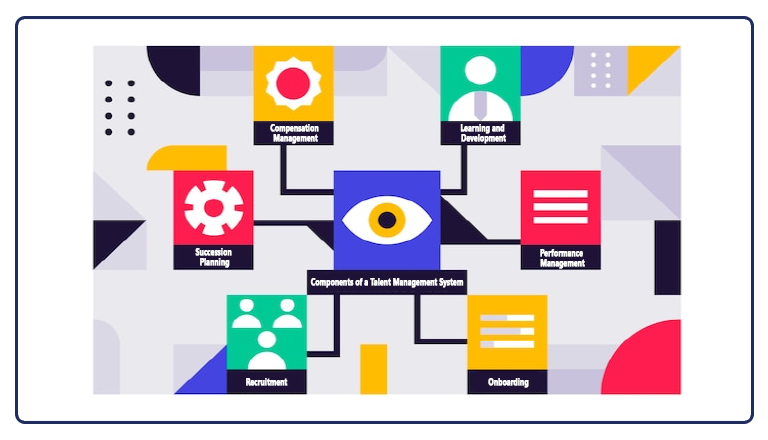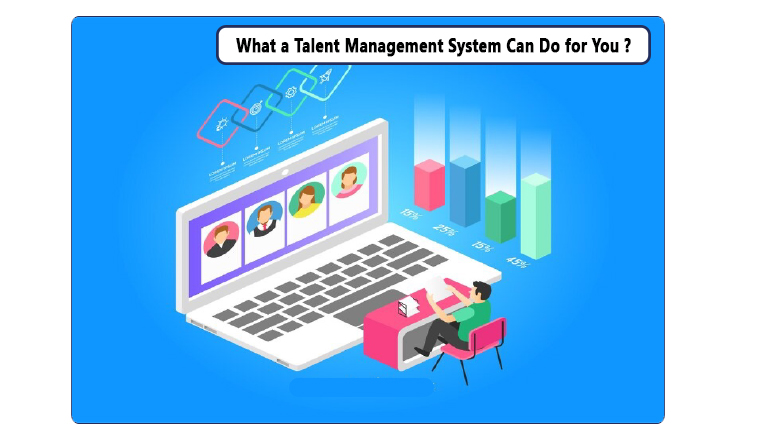Talent management is the art and science of strategically identifying, acquiring, developing, and retaining the right talent to drive your organization’s success. It’s not just about filling positions; it’s about cultivating a culture that values and nurtures individual abilities and potential. It is a deliberate and strategic endeavor that aligns your organization’s objectives with the skills and aspirations of your employees, creating a harmonious synergy that propels both your organization and your employees forward.
Managing your organizational talent plays a great role in enhancing employee engagement, increasing productivity, reducing turnover rates, and ensuring you have the right people at the right place at all times. Companies that excel in talent management produce nearly 50% higher revenue per employee than those that don’t. And the results get even better when you employ a talent management system.
So, what is a Talent Management System?
A talent management system is a suite of tools, usually composed of modules, together designed to streamline and automate various aspects of talent management. These modules enable you to streamline your HR processes, increase efficiency, and make data-driven talent decisions. By doing less of what does not matter, talent management systems help you focus more on strategic initiatives and putting the human touch to human resources.

Components of a Talent Management System
Talent management systems are composed of several modules, each usually responsible for one stage in the employee experience journey. You can always choose to opt for a single module, all modules, or anything in between.
Here are the main modules you would usually find in a talent management system:
1. Recruitment:
The recruitment module in a talent management system usually offers features such as applicant tracking, candidate sourcing, and collaborative hiring. These tools simplify the recruitment workflow, making it easier for you to manage job postings, track applicants, and evaluate candidates more efficiently by providing tools for resume screening, skills assessments, and interview scheduling. Not only do recruitment modules help organizations attract top talent by simplifying the recruitment process, but they also provide candidates with a better candidate experience. They provide them with a centralized platform to apply for jobs, submit their resumes, and track their application status, thus, reducing communication gaps between candidates and recruiters.
The recruitment module in a talent management system also provides you with valuable insights into recruitment metrics such as time-to-fill, cost-per-hire, and source of hire. These analytics help you make data-driven decisions to optimize your recruitment strategies and improve overall hiring outcomes.
2. Onboarding:
Including an onboarding module in your talent management system helps you improve new hire engagement and retention. An onboarding module offers features such as digital onboarding checklists, automated workflows, self-service portals, new hire paperwork automation, and compliance training. These features simplify the onboarding workflow, make it easier for you to track the new hires’ progress, ensure your compliance with legal requirements, and provide an overall superior employee experience. Knowing that effective employee onboarding can improve employee retention by 82%, these onboarding journey enhancements cannot be underestimated.
An onboarding module also enables you to evaluate new hires more efficiently by providing tools for skills assessments, performance reviews, and feedback collection. It also provides you with valuable insights into onboarding metrics such as time-to-productivity, engagement levels, and retention rates. These analytics help you design your onboarding journeys more efficiently and effectively.
3. Performance Management:
Performance management is one of the central modules in any talent management system. As the name implies, it helps you improve your overall organizational performance by aligning employee goals with business objectives.
A performance management module provides a singular platform for managing performance, that comes with handy features such as goal setting, performance reviews, feedback tools, skills assessments, 360-degree feedback, and performance analytics. These features simplify the performance management workflow, making it easier for everybody in your organization, managers and employees alike, to manage goals, evaluate performance, and track progress.
Using such a data-based, accessible platform helps maintain a fair and transparent performance management process and provides you with valuable insights into performance metrics such as goal attainment, skill development, and engagement levels.
4. Learning and Development:
Including a learning and development module in your talent management suite is a great plus. L&D modules simplify the learning and development workflow, making it easier for you to manage training programs, track employee progress, and more efficiently develop employees’ skills and knowledge.
It all starts with skills assessments that help you identify skills gaps within your workforce, thus enabling you to design personalized, targeted learning experiences for your employees based on their skills, interests, and career goals. Moreover, many L&D modules come with a wide library of online learning resources, such as e-learning courses, webinars, and virtual classrooms, that help your employees learn at their own pace anytime, anywhere.
5. Compensation Management:
A compensation management module in your talent management suite helps you ensure that your organizational compensation schemes are competitive and transparent. With features such as salary benchmarking, bonus planning, and equity management, compensation modules streamline compensation processes around your organization, thereby ensuring that employees are fairly compensated for their work. By accurately and fairly allocating bonuses, awards, and merit-based compensation, these modules help you retain top talent.
The cherry on top of the cake is that by automating manual compensation processes such as salary calculations, bonus allocations, benefits administration, and report generation, you save time and reduce your administrative costs. Knowing that HR managers lose 14 hours per week on tasks that can be automated, the time-saving benefits of using a compensation module cannot be underestimated.
6. Succession Planning:
Succession planning in a talent management system automates your succession planning process, helping you objectively assess and identify high-potential employees to develop them for future leadership and key position roles. This ensures a smooth transition when key employees leave or retire and improves employee retention as employees enjoy clear growth paths within your organization. Unsurprisingly, some of the features to expect in a succession planning module are career pathing, talent mapping, and leadership development.
Perhaps, the key advantage of succession planning modules is that by providing objective insights into employee performance, potential, and readiness for advancement, they help you base these critical succession decisions on data and evidence, instead of gut feeling and bias.

How to Select the Right Talent Management System for You
Now that you know the value a talent management system can bring to your organization, it is crucial that you select the right one that works for you. We have compiled these steps to help you make this decision wisely:
- Assess Your Organization’s Needs: When you want to make change, it may seem tempting to try to do a lot at once. However, that would be counterproductive and would deprive you of many lessons learned along the way. Instead, start by evaluating your organization’s talent management requirements, identify the key areas where you need support, and invest in relevant modules first.
- Define Your Objectives: Clearly define what you want to achieve with the new talent management system to evaluate your options based on clear criteria.
- Research Available Solutions: Conduct thorough research on available talent management suites. Read reviews and ratings from trusted sources and consider factors such as functionality, ease of use, customization options, integration capabilities, scalability, and vendor reputation. One of the best ways to check for reputation is to ask for references and recommendations from other organizations that have implemented the talent management system you are considering to gain insights into their experience.
- Evaluate Vendor Expertise: Assess the expertise and experience of potential vendors. You want a vendor with a proven track record in talent management systems development and implementation, relevant industry knowledge, good customer support, and the ability to meet your organization’s unique requirements.
- Request Demos and Trials: Request demos or trials from shortlisted vendors to get hands-on experience with their systems. Evaluate the user interface, features, and overall user experience. Don’t make this decision alone; involve key stakeholders from other relevant departments in the evaluation process.
- Consider Integration Capabilities: Ensure that the talent management system you are considering can seamlessly integrate with your current systems, such as HRIS (Human Resources Information System), payroll software, or learning management systems.
- Check Data Security and Compliance: Verify that the talent management system you are considering complies with data security regulations and industry standards. Consider factors such as data encryption, access controls, backup and recovery mechanisms, and compliance with local or global privacy laws.
- Evaluate Total Cost of Ownership: Consider the total cost of ownership for the talent management system. Evaluate factors such as licensing fees, implementation costs, ongoing maintenance fees, training expenses, and potential customization or integration costs.
- Make an Informed Decision: Based on your evaluation and analysis, select the talent management system that best aligns with your organization’s needs and objectives.
Choose the Right Talent Management System for You
Remember that choosing the right talent management system is a critical decision that can impact your organization’s talent management effectiveness. Take your time to evaluate different options and involve key stakeholders in the decision-making process.
At XpertLearning, we’re experts in talent management systems. If you’re interested in knowing more about our talent management solutions or are interested in viewing a live demo, you can visit our talent management solutions page.

